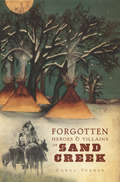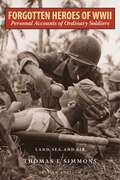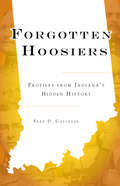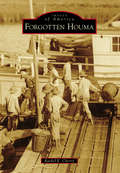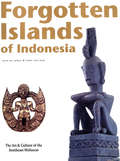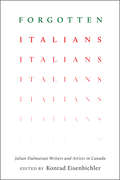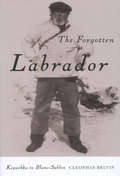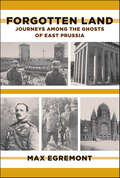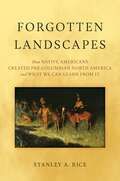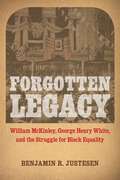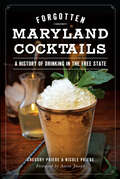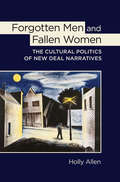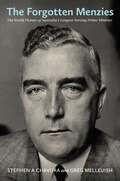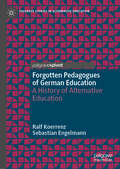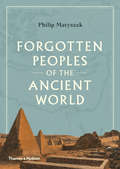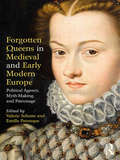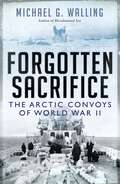- Table View
- List View
Forgotten Heroes and Villains of Sand Creek
by Carol TurnerOn November 29, 1864, Colonel John Chivington led a bloody and terrible raid on an encampment of Arapaho and Cheyenne who had come to the area believing they were on a path to peace. Before it was over, between 130 and 180 Native Americans had been massacred. This attack, known as the Sand Creek Massacre, is one of the most well-known and notorious events in Colorado's history. In Forgotten Heroes and Villains of Sand Creek, author Carol Turner turns an eye to the central characters, their histories and how they came to be part of this bloody episode. This fascinating look at such a pivotal event, its instigators and its martyrs includes the stories of John Chivington, am ambitious preacher with a streak of cruelty; Captain Silas Soule, a man who is still honored today by the Cheyenne and Arapaho tribes for his efforts in saving their ancestors; Ned Wynkoop, one of Soule's compatriots who had a change of heart regarding the tribes; Chief One Eye, a persuasive and charismatic medicine m
Forgotten Heroes of World War II: Personal Accounts of Ordinary Soldiers—Land, Sea, and Air
by Thomas E. SimmonsWorld War II was the defining event of the twentieth century. For everyone it was a time of confusion, fear, destruction, and death on a scale never before seen. Much has been written of the generals, campaigns, and battles of the war, but it was young, ordinary American kids who held our freedom in their hands as they fought for liberty across the globe. Forgotten Heroes of World War II offers a personal understanding of what was demanded of these young heroes through the stories of rank-and-file individuals who served in the navy, marines, army, air corps, and merchant marine in all theaters of the war. Their tales are told without pretense or apology. At the time, each thought himself no different from those around him, for they were all young, scared, and miserable. They were the ordinary, the extraordinary—the forgotten.
Forgotten Hoosiers: Profiles from Indiana's Hidden History (Forgotten Tales)
by Fred D. CavinderVowing to overcome the sin of seriousness, Indiana-born humorist Don Herold lived up to his promise. Gifted with a droll sense of humor and a vivid imagination, he was one of the most widely read, if least remembered, Hoosiers. In Forgotten Hoosiers, journalist Fred D. Cavinder presents a collection of biographical sketches charting the lives of noteworthy Hoosiers who have been overlooked, as well as acclaimed figures whose Hoosier origins have been obscured. From Harland David Sanders, the pioneering Kentucky colonel who developed the world-famous chicken franchise, to Samuel G. Woodfill, whom many have called the greatest hero of World War I, Hoosiers- both known and unknown- have continued to make their marks across the country and the world.
Forgotten Houma
by Rachel E. CherryHouma officially became the seat of Terrebonne Parish in 1848; however, the area known as "terre bonne" ("the good earth") was inhabited much earlier. The Houma tribe settled the land as early as 1760, Arcadian French settlers arrived by 1785, Spanish settlers by 1790, and wealthy English landowners established the area's first plantations in 1828. Agriculture, hunting, and fishing activities such as oyster harvesting and shrimp drying were prominent occupations in the parish until the oil and gas industry took hold of the economy in the 1920s. Seemingly endless waterways, marshes, and bays, coupled with fertile farmland and oil production, helped foster Houma's lucrative economy; likewise, a blend of customs, traditions, and natural disasters have shaped its unique culture. Forgotten Houma uses vintage photographs to capture the community before modernization and destruction, awakening the spirits of former residents and the memories of earlier ways of life.
Forgotten Islands of Indonesia
by Joss Van Dijk Nico DejongeThis beautiful book contains over 170 unique photographs and pictures of one of the most interesting but least well known cultures in the Indonesian Archipelago.The traditional art of Maluku Tenggara, the Southeast Moluccas, is among the most sophisticated and expressive in the world. Simple tools were used to create masterpieces in wood, stone, textiles and precious metals, while the plaited work and earthenware of these islands are also of the very highest quality.the colonial period plunged the region into hopeless isolation. During the harsh rule of the Dutch many traditional woks of art, especially ancestor statues, were destroyed. Later, collectors stripped the islands of their masterpieces and the culture of Maluka Tenggara was forgotten.Forgotten Islands of Indonesia presents a unique survey of the finest examples of Southeast Moluccan art. This volume contains many photographs and descriptions which have never before been published. Set against the cultural background and supplemented by rare photographs taken in the field, the material culture of Maluku Tenggara, which is regarded as one of the most fascinating areas of Indonesia, is presented here comprehensively for the first time.
Forgotten Italians: Julian-Dalmatian Writers and Artists in Canada (Toronto Italian Studies)
by Konrad EisenbichlerScholarship on Italian emigration has generally omitted the Julian-Dalmatians, a group of Italians from Istria and Dalmatia, two regions that, in the wake of World War Two, were ceded by Italy to Yugoslavia as part of its war reparations to that country. Though Italians by language culture, and traditions, it seems that this group has been conveniently excised from history. And yet, Julian-Dalmatians constitute an important element in twentieth-century Italian history and represent a unique aspect of both Italian culture and emigration. This ground-breaking collection of articles from an international team of scholars opens the discussion on these “forgotten Italians” by briefly reviewing the history of their diaspora and then by examining the literary and artistic works they produced as immigrants to Canada. Forgotten Italians offers new insights into such celebrated authors as Diego Bastianutti, Mario Duliani, Caterina Edwards, and Gianni Angelo Grohovaz, as well as visual artists such as Vittorio Fiorucci and Silvia Pecota. Profoundly marked by the experience of being uprooted and forced into exile, by life in refugee camps, and by the encounter with a new culture, first-generation Julian-Dalmatians in Canada used art and writing to come to terms with their anguished situation and to rediscover their cultural roots.
Forgotten Kings: The Story of the Hindu Sahi Dynasty
by Changez Jan&‘This Hindu Sahiya dynasty is now extinct, and of the whole house there is no longer the slightest remnant in existence. We must say that, in all their grandeur, they never slackened in the ardent desire of doing that which is good and right, that they were men of noble sentiment and noble bearing.&’People and their acts of bravery are often lost to the annals of history. But what of mighty lineages? Generations of kings and the lands and people they fought for? What of kings who fought against their own people?The Hindu Sahi kings, to whom honour and pride were more important than their own survival, fought a near 150 year rear-guard action as they continued to be pushed east from Kabul, their original homeland, changing their capitals and defending themselves from their own countrymen.The last of their house had the misfortune of confronting the juggernaut that was Sultan Mahmud of Ghazni. Where obedience to the Sultan would have allowed their house to endure, their honour would have them confront him over and over.But who were they?This book tries to piece together their story from the limited sources that are available from an age where historical sources were few and, in the case of the Sahis, mostly from the point of view of their enemies.This is the story of a dynasty that represented a resurgent Hindu faith in a land that was long dominated by Buddhism but also coincided with the arrival of the Muslims.
Forgotten Labrador
by Cleophas BelvinCleophas Belvin describes the arrival of the Aboriginals and the activities of the Breton and Basque fishermen and French-and English-speaking merchants from Quebec City who controlled the region for more than one hundred and fifty years. He paints a vivid picture of the lifestyle and living conditions of the early French- and English-speaking pioneers and their descendants, offering an analysis of why they settled in the region and how they dealt with the precariousness of the seal, salmon, and cod fisheries. The Forgotten Labrador also explores the role of the Anglican and Catholic missionaries, the establishment of educational, medical, transportation, and communication services and the various government and local initiatives that were undertaken to provide the people with some form of economic prosperity.
Forgotten Labrador: Kegashka to Blanc-Sablon
by Cleophas BelvinThe Forgotten Labrador recounts the history of a remarkable area of Canada - the Quebec part of the Labrador coast that extends eastward from Kegashka to Blanc Sablon. Cleophas Belvin describes the arrival of the Aboriginals and the activities of the Breton and Basque fishermen and French- and English-speaking merchants from Quebec City who controlled the region for more than one hundred and fifty years. He paints a vivid picture of the lifestyle and living conditions of the early French- and English-speaking pioneers and their descendants, offering an analysis of why they settled in the region and how they dealt with the precariousness of the seal, salmon, and cod fisheries. The Forgotten Labrador also explores the role of the Anglican and Catholic missionaries, the establishment of educational, medical, transportation, and communication services, and the various government and local initiatives that were undertaken to provide the people with some form of economic prosperity.
Forgotten Land: Journeys Among the Ghosts of East Prussia
by Max EgremontUntil the end of World War II, East Prussia was the German empire's farthest eastern redoubt, a thriving and beautiful land on the southeastern coast of the Baltic Sea. Now it lives only in history and in myth. Since 1945, the territory has been divided between Poland and Russia, stretching from the border between Russia and Lithuania in the east and south, and through Poland in the west. In Forgotten Land, Max Egremont offers a vivid account of this region and its people through the stories of individuals who were intimately involved in and transformed by its tumultuous history, as well as accounts of his own travels and interviews he conducted along the way.Forgotten Land is a story of historical identity and character, told through intimate portraits of people and places. It is a unique examination of the layers of history, of the changing perceptions and myths of homeland, of virtue and of wickedness, and of how a place can still overwhelm those who left it years before.
Forgotten Landscapes: How Native Americans Created Pre-Columbian North America and What We Can Learn From It
by Stanley A. RiceRediscover the thriving civilizations of Pre-Columbian America and learn how Native ingenuity transformed the landscape into a flourishing world we can still learn from today North America was not empty nor were its inhabitants savages when Europeans arrived in 1492. Quite the opposite, North America was thickly populated by indigenous people who lived in clean cities, had a thriving economy, and transformed the landscape into bountiful productivity. Forgotten Landscapes reveals the incredible extent to which Native Americans manipulated and shaped their surrounding environs through agricultural practices and urban engineering, resulting in one of the most prosperous civilizations of their time. Well before European contact, North American cities and villages were bound together by an intricate trade network. Today, Spiro Mound in rural Oklahoma is a few piles of dirt, not on the road to anywhere. But at the time of the Mississippian civilization, about a thousand years ago, it was one of the largest cities in the world. With the controlled use of fire, Native Americans had transformed thick forests into open woodlands and expanded the ranges of prairies. Through organized hunting, Natives controlled the populations of prey animals such as passenger pigeons, and when Native populations grew large enough, they developed agriculture including irrigated crops, and even orchards. In this fascinating and overdue book, author Stanley A. Rice shows readers the Pre-Columbian landscape of America that has been largely forgotten.
Forgotten Legacy: William McKinley, George Henry White, and the Struggle for Black Equality
by Benjamin R. JustesenIn Forgotten Legacy, Benjamin R. Justesen reveals a previously unexamined facet of William McKinley’s presidency: an ongoing dedication to the advancement of African Americans, including their appointment to significant roles in the federal government and the safeguarding of their rights as U.S. citizens. During the first two years of his administration, McKinley named nearly as many African Americans to federal office as all his predecessors combined. He also acted on many fronts to stiffen federal penalties for participation in lynch mobs and to support measures promoting racial tolerance. Indeed, Justesen’s work suggests that McKinley might well be considered the first “civil rights president,” especially when compared to his next five successors in office. Nonetheless, historians have long minimized, trivialized, or overlooked McKinley’s cooperative relationships with prominent African American leaders, including George Henry White, the nation’s only black congressman between 1897 and 1901. Justesen contends that this conventional, one-sided portrait of McKinley is at best incomplete and misleading, and often severely distorts the historical record. A Civil War veteran and the child of abolitionist parents, the twenty-fifth president committed himself to advocating for equity for America’s black citizens. Justesen uses White’s parallel efforts in and outside of Congress as the primary lens through which to view the McKinley administration’s accomplishments in racial advancement. He focuses on McKinley’s regular meetings with a small and mostly unheralded group of African American advisers and his enduring relationship with leaders of the new National Afro-American Council. His nomination of black U.S. postmasters, consuls, midlevel agency appointees, military officers, and some high-level officials—including U.S. ministers to Haiti and Liberia—serves as perhaps the most visible example of the president’s work in this area. Only months before his assassination in 1901, McKinley toured the South, visiting African American colleges to praise black achievements and encourage a spirit of optimism among his audiences. Although McKinley succumbed to political pressure and failed to promote equality and civil rights as much as he had initially hoped, Justesen shows that his efforts proved far more significant than previously thought, and were halted only by his untimely death.
Forgotten Lives: African Americans in South Dakota
by Betti Carol Vanepps-TaylorThroughout South Dakota's history, African Americans have been vastly outnumbered by their white and American Indian neighbors. Under-reported as well, they have been misrepresented by historians, journalists, even census-takers. However, from the first African Americans to visit the Northern Great Plains as fur traders in the early 1800s to twentieth-century voting-rights advocates or professionals recruited after World War II, African Americans have pioneered here. They have participated in the state's successes and failures and contributed to its rich history.
Forgotten Maryland Cocktails: A History of Drinking in the Free State (American Palate Ser.)
by Gregory Priebe Nicole PriebeThe Southside, Diamondback and the Preakness--Marylanders imbibe history in their native cocktails, from local favorites to little-known classics. Early residents favored fruit brandies and potent punches until the Civil War, when rye whiskey laid claim to local palates. During the golden age of the cocktail, grand hotels like Baltimore's Belvedere created smooth concoctions such as the Frozen Rye, but the dry days of Prohibition interrupted the good times. Using historic recipes with modern twists from renowned mixologists, Greg and Nicole Priebe mix up one part practical guide and three parts Maryland history and top it off with a tour of the current craft cocktail and distilling scenes.
Forgotten Men and Fallen Women: The Cultural Politics of New Deal Narratives
by Holly AllenDuring the Great Depression and into the war years, the Roosevelt administration sought to transform the political, institutional, and social contours of the United States. One result of the New Deal was the emergence and deployment of a novel set of narratives—reflected in social scientific case studies, government documents, and popular media—meant to reorient relationships among gender, race, sexuality, and national political power. In Forgotten Men and Fallen Women, Holly Allen focuses on the interplay of popular and official narratives of forgotten manhood, fallen womanhood, and other social and moral archetypes. In doing so, she explores how federal officials used stories of collective civic identity to enlist popular support for the expansive New Deal state and, later, for the war effort.These stories, she argues, had practical consequences for federal relief politics. The “forgotten man,” identified by Roosevelt in a fireside chat in 1932, for instance, was a compelling figure of collective civic identity and the counterpart to the white, male breadwinner who was the prime beneficiary of New Deal relief programs. He was also associated with women who were blamed either for not supporting their husbands and family at all (owing to laziness, shrewishness, or infidelity) or for supporting them too well by taking their husbands’ jobs, rather than staying at home and allowing the men to work.During World War II, Allen finds, federal policies and programs continued to be shaped by specific gendered stories—most centrally, the story of the heroic white civilian defender, which animated the Office of Civilian Defense, and the story of the sacrificial Nisei (Japanese-American) soldier, which was used by the War Relocation Authority. The Roosevelt administration’s engagement with such widely circulating narratives, Allen concludes, highlights the affective dimensions of U.S. citizenship and state formation.
Forgotten Men: The Australian Army Veterinary Corps 1909-1946 (Big Sky Publishing Ser.)
by Michael TyquinForgotten Men is the long overdue account of the significant contribution to the Australian Army of the Australian Army Veterinary Corps in two world wars. One of the army's smallest and least recognised corps, its humble beginnings and quiet work in the background belie the crucial role of the Corps in supporting wartime operations and dealing with logistical issues never envisaged before 1915. While their place in military history is often overlooked, the men of the Australian Veterinary Corps deserve recognition. Stoic and hardworking, they unselfishly worked among the horrors of war, to provide the support needed for army units and their animals. While the Veterinary Corps reached its peak during the Great War, its role did not end when the guns fell silent in 1918. Instead, the Corps continued to support military activities across Australia until horsepower finally gave way to mechanisation in World War II. The Corps' success in enabling the 1st Australian Imperial Force to fight in two theatres, each with its own peculiar veterinary problems, is an achievement worth recording. Doctor Michael Tyquin is a consulting historian based in Canberra. He has published extensively in the areas of Australian social, medical and military history. He is a serving member of the Australian Army Reserve which he joined as a medical assistant with the 4/19th Prince of Wales Light Horse. He is the official historian of the Royal Australian Army Medical Corps and is an Adjunct Professor at the University of Queensland's Centre for Military and Veterans' Health.
Forgotten Menzies: The World Picture of Australia's Longest-Serving Prime Minister
by Stephen Chavura Greg MelleuishSir Robert Gordon Menzies was the founder of the Liberal Party of Australia. As well as being Australia's longest-serving prime minister, Menzies was the most thoughtful. Menzies' world picture was one where Britishness was the overriding normative principle, and in which cultural puritanism and philosophical idealism were pervasive. Unless we remember this cultural background of Menzies' thought then we will seriously misunderstand what he meant by the very project of liberalism. The Forgotten Menzies argues that Menzies' greatest aspiration was to protect the ideals of cultural puritanism Australia from two kinds of materialism: communism; and the mindset encouraged by affluence and technological progress. Central to Menzies' project of cultural and civilisational preservation was the university, an institution he spent much of his career extolling and expanding. The Forgotten Menzies makes an important contribution to the history of political thought and ideology in Australia, as to understanding the largely forgotten but rich intellectual origins of the Liberal Party.
Forgotten Patriots: The Untold Story of American Prisoners During the Revolutionary War
by Edwin G. BurrowsBetween 1775 and 1783, some 200,000 Americans took up arms against the British Crown. Just over 6,800 of those men died in battle. About 25,000 became prisoners of war, most of them confined in New York City under conditions so atrocious that they perished by the thousands. Evidence suggests that at least 17,500 Americans may have died in these prisons--more than twice the number to die on the battlefield. It was in New York, not Boston or Philadelphia, where most Americans gave their lives for the cause of independence. New York City became the jailhouse of the American Revolution because it was the principal base of the Crown’s military operations. Beginning with the bumper crop of American captives taken during the 1776 invasion of New York, captured Americans were stuffed into a hastily assembled collection of public buildings, sugar houses, and prison ships. The prisoners were shockingly overcrowded and chronically underfed--those who escaped alive told of comrades so hungry they ate their own clothes and shoes. Despite the extraordinary number of lives lost, Forgotten Patriots is the first-ever account of what took place in these hell-holes. The result is a unique perspective on the Revolutionary War as well as a sobering commentary on how Americans have remembered our struggle for independence--and how much we have forgotten.
Forgotten Peace: Reform, Violence, and the Making of Contemporary Colombia
by Robert A. KarlForgotten Peace examines Colombian society’s attempt to move beyond the Western Hemisphere’s worst mid-century conflict and shows how that effort molded notions of belonging and understandings of the past. Robert A. Karl reconstructs encounters between government officials, rural peoples, provincial elites, and urban intellectuals during a crucial conjuncture that saw reformist optimism transform into alienation. In addition to offering a sweeping reinterpretation of Colombian history—including the most detailed account of the origins of the FARC insurgency in any language—Karl provides a Colombian vantage on global processes of democratic transition, development, and memory formation in the 1950s and 1960s. Broad in scope, Forgotten Peace challenges contemporary theories of violence in Latin America.
Forgotten Pedagogues of German Education: A History of Alternative Education (Palgrave Studies in Alternative Education)
by Ralf Koerrenz Sebastian EngelmannThis book introduces six pedagogues from the German context to an English-speaking audience, and demonstrates their significant contribution to the field of alternative education. First and foremost, the authors emphasise the importance of understanding the history of education, to realise that in fact what we understand as ‘normal’ today is by no means the only course history could have taken. The quest for alternative ways of schooling goes back to the late eighteenth century, where educational thinkers advocated various approaches in the face of rapid societal change. The chosen six thinkers are not well known in the English-speaking scientific community, and some are even infrequently cited in the German context. In offering an historic and systematic introduction to concepts that can frame Alternative Education in different ways, this book allows the reader to critically reevaluate present forms of education by using the past as a mirror.
Forgotten Peoples of the Ancient World
by Philip MatyszakA chronicle of forty forgotten ancient civilizations which highlights the important contributions that each has made to modern society. The ancient world of the Mediterranean and the Near East saw the birth and collapse of great civilizations. While several of these are well known, for all those that have been recorded, many have been unjustly forgotten. Our history is overflowing with different cultures that have all evolved over time, sometimes dissolving or reforming, though ultimately shaping the way we continue to live. But for every culture that has been remembered, what have we forgotten? This thorough guide explores those civilizations that have faded from the pages of our textbooks but played a significant role in the development of modern society. Forgotten Peoples of the Ancient World covers the Hyksos to the Hephthalites and everyone in between, providing a unique overview of humanity’s history from approximately 3000 BCE–550 CE. A wide range of illustrated artifacts and artworks, as well as specially drawn maps, help to tell the stories of forty lost peoples and allow readers to take a direct look into the past. Each entry exposes a diverse culture, highlighting their important contributions and committing their achievements to paper. Forgotten Peoples of the Ancient World is an immersive, thought-provoking, and entertaining book for anyone interested in ancient history.
Forgotten Queens (Images of America)
by Kevin Walsh Greater Astoria Historical SocietyIn the early years of the 20th century, Queens County underwent an enormous transformation. The Queensboro Bridge of 1909 forever changed the landscape of this primarily rural area into the urban metropolis it is today. Forgotten Queens shows New York’s largest borough between the years 1920 and 1950, when it was adorned with some of the finest model housing and planned communities anywhere in the country. Victorian mansions, cookie-cutter row houses, fishing shacks, and beachside bungalows all coexisted next to workplaces and commercial areas. Beckoning with the torch of the new century and a bright promise for those who dared to pioneer its urban wilderness, Queens flourished as a community. Through vintage photographs being seen by the public for the first time, the five wards of Queens are highlighted for their unique character and history.
Forgotten Queens in Medieval and Early Modern Europe: Political Agency, Myth-Making, and Patronage
by Valerie Schutte Estelle ParanqueForgotten Queens in Medieval and Early Modern Europe examines queens dowager and queens consort who have disappeared from history or have been deeply misunderstood in modern historical treatment. Divided into eleven chapters, this book covers queenship from 1016 to 1800, demonstrating the influence of queens in different aspects of monarchy over eight centuries and furthering our knowledge of the roles and challenges that they faced. It also promotes a deeper understanding of the methods of power and patronage for women who were not queens, many of which have since become mythologized into what historians have wanted them to be. The chronological organisation of the book, meanwhile, allows the reader to see more clearly how these forgotten queens are related by the power, agency, and patronage they displayed, despite the mythologization to which they have all been subjected. Offering a broad geographical coverage and providing a comparison of queenship across a range of disciplines, such as religious history, art history, and literature, Forgotten Queens in Medieval and Early Modern Europe is ideal for students and scholars of pre-modern queenship and of medieval and early modern history courses more generally.
Forgotten Royal Women: The King and I
by Erin LawlessBehind-the-throne biographies of royal sisters, mothers, and others. It&’s said that behind every great man is a woman, and what man is greater than the king? For centuries, royal aunts, cousins, sisters and mothers have watched history unfold from the shadows, their battlefields the bedchamber or the birthing room, their often short lives remembered only through the lens of others. But for those who want to hear them, great stories are still there to be told: the medieval princess who was kidnapped by pirates; the duchess found guilty of procuring love potions; the queen who was imprisoned in a castle for decades. Bringing thirty of these royal women out of the shadows, along with the footnotes of their families, this collection of bite-sized biographies will tell forgotten tales and shine much needed light into the darkened corners of women&’s history—and reminds us that British history is more than just a chain of Edwards and Henrys and Georges.
Forgotten Sacrifice: The Arctic Convoys of World War II
by Michael WallingHitler called Norway the "Zone of Destiny" for Nazi Germany because convoys from Churchill's Britain and Roosevelt's United States supplied Stalin's Soviet Russia with critical equipment and foodstuffs during the darkest days of the German invasion.The words "Murmansk Run" conjure visions of ice-laden ships and thoughts of freezing to death in seconds. For five long years, thousands of men and women fought ferociously in the coldest corner of hell on earth. Some fought for survival, some struggled to help others survive, and some sought to crush their enemies. If man-made death didn't get you, the Arctic's weapons of ice and cold would. These natural weapons killed regardless of whose side you were on or how just was your cause. No one escaped unscathed. Author Mike Walling captures the Arctic convoys' bitter essence in Forgotten Sacrifice. The story launches in October 1939, when Germany and the Soviet Union began diplomatic maneuvering. The action accelerates with Winston Churchill's decision in 1941 to provide supplies to Soviet forces battling the German invasion. From this point until the closing days of WWII in spring 1945, an unremitting sea battle raged within the confines of the always-lethal, ever-shifting Arctic ice pack and the savage Scandinavian coastline. Nearly 4.5 million tons of supplies were moved in 77 convoys over the course of 5 years in order to help the Soviet war effort. The Allies fought to keep the sea lanes open to Murmansk while the Germans were determined to slaughter every ship which dared to make the attempt. By the end of the convoys, 98 ships had been lost. Forgotten Sacrifice reveals a timeless tale of determination, heroism, sacrifice, and the strength of the human spirit.From the Hardcover edition.
